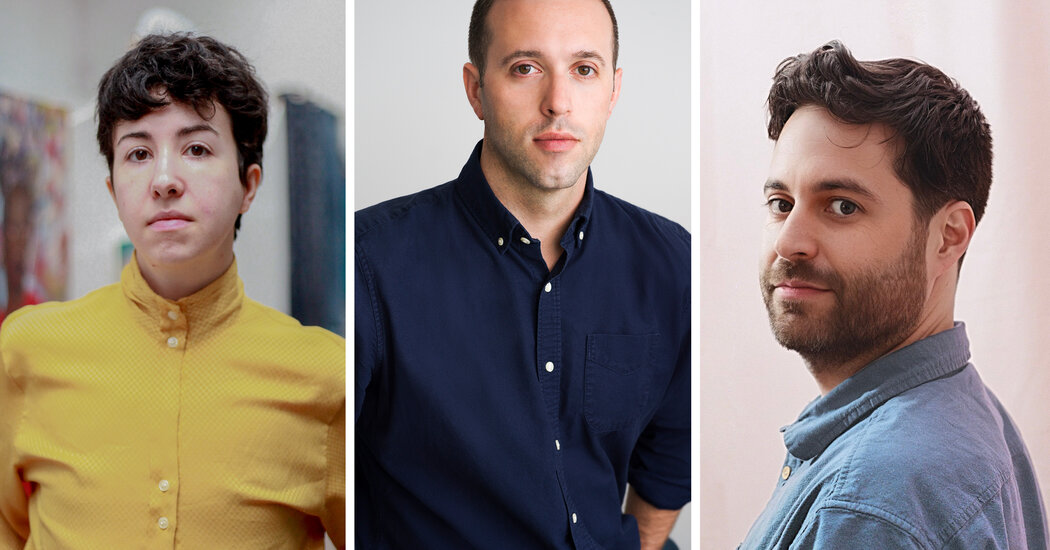Near the end of Daniel Lefferts’s recent novel, “Ways and Means,” the protagonist — a gay and ambitious but disastrously wayward college student — takes an unexpected turn for a queer character: He finds salvation in God.
And in the closing pages, as he reunites with the man he loves, he warns that he’s “still doing the religion stuff.” It’s the kind of moment you would rarely come across in mainstream gay fiction until this year, when suddenly it isn’t so out of place.
After “Ways and Means” came Garrard Conley’s novel “All the World Beside,” a revisionist history of gay Puritans, and, this month, Allen Bratton’s “Henry Henry,” a tragicomic, modern retelling of Shakespeare’s Henriad whose main character is an uncompromising Catholic.
“This isn’t something that I’ve seen a lot of,” Lefferts said in an interview. “But it’s exciting and just kind of strange that it’s happening now.”
Faith has never been too far from gay literature. There is a rich history of queer theology that seeks to reconcile sexuality and religion, like the theologian John J. McNeil’s “The Church and the Homosexual,” from 1976. The novelist Colm Toibin writes from a distinctly Catholic perspective, and Garth Greenwell’s books have been described as imbuing sex with spiritual transcendence. Robert Glück’s experimental novel “Margery Kempe” (1994) intertwines a historical nun’s pornographic ecstasy and modern gay desire — an adoption of Christianity similar to the lasting image of St. Sebastian, his nearly naked body penetrated by arrows, in gay culture.
Less common, however, is the kind of gay Christianity represented in “Ways and Means,” “All the World Beside” and “Henry Henry,” books that feature characters whose faith is rooted less in spirituality than in the institution of religion. And that, these novels’ authors say, may be truer to life today.
“I know a lot of people who are both queer and religious: queer Catholics, queer Protestants, queer Mormons.” Bratton said. “With queer Catholics, it’s usually a situation where they’ve grown up Catholic and their culture is broadly Catholic — just a way of life, and a fact of life.”
In writing “Henry Henry,” Bratton didn’t want to fall into the trope of irreconcilable sexuality and Catholicism — “the narrative of ‘never the twain shall meet,’ because I think the twain has met a lot.” For decades, though, there has been a popular conception of gayness and religion as oppositional forces, a cliché perpetuated both by rebellious atheists and by severely homophobic institutions like the Westboro Baptist Church.
But both religion and queer culture are too nimble to remain at odds. Although the Catholic Church hasn’t entirely embraced queerness — this month the Vatican issued a document saying that gender confirmation surgery threatened “the unique dignity” of life — it has made relative strides in recent years.
As religious institutions navigate their relationship with queer people, so too have queer people — often unconventional by nature — and the authors of these recent novels approached faith differently.
In “All the World Beside,” set in the 18th century, gay characters (and others) lack the vocabulary to describe their desires. Nathaniel and Arthur, the couple at the heart of the story, barely consummate their love and seem unable even to fathom a life together. But they know what their feelings mean: that while they may be antithetical to religious life, they are akin to religious experience.
“Arthur feels that he’s closer to God when he’s truthful about himself with Nathaniel,” Conley said. “I thought it was important to imagine a conversation where people were free enough to say, ‘This connection between my love and my heart is drawing me closer to God,’ which is what I felt the first time I hooked up with a guy. I felt an embodiment of love, and all the things you’re supposed to feel during communion.”
Hal, of “Henry Henry,” comes from an aristocratic English family whose Catholicism goes back centuries, to when it “was the law of the land,” Bratton said. They never converted to Anglicanism, even as Catholics were persecuted. It is a crucial part of Hal’s identity, though it is challenged by his boyfriend, who, in one argument, says that he finds Hal’s devotion to the church weird, unnecessary and even harmful.
“I felt that it was inevitable that there will be people who say, ‘I just don’t get it, and I don’t respect it,’” Bratton said. But Hal doesn’t have a subsequent crisis of faith or undergo the kind of soul-searching that brings him a fresh sense of self. He chooses to live the way he wants while being religious, with no concern about whether or how those will be reconciled.
Lefferts, who set “Ways and Means” during the months leading up to the 2016 U.S. presidential election, doesn’t bring faith into the story until its final chapters. By that point, he said, “I already packed the car, thematically. One more suitcase and you wouldn’t be able to close the door.”
Still, the only resolution that made sense for Alistair, his young protagonist, was religious salvation. “I was thinking about the ways in which we have these objects that we overidealize and overinvest with meaning,” Lefferts said. “I started to wonder if the original longing that humans have is always God. In a secularized and neoliberal world, we have substitutes for that. But what would it mean to return to God and reject those things, for Alistair to renounce his ambitions and find this Christian corrective?”
The religious choices of these characters bear some, but not much, resemblance to those of their authors. Conley, 38, grew up in a fundamentalist Christian household, then lost his faith during the conversion therapy he chronicled in his memoir, “Boy Erased.” Today, though, he feels a belief in God, and he has resisted villainizing the church; he didn’t want to establish an “us versus them” opposition in “Boy Erased,” he said, because “there’s a lot of ‘us’ in the group of ‘them.’”
Bratton, 30, didn’t want to say much about his religious beliefs, for fear that readers might project his biography onto “Henry Henry,” but he said: “I don’t know what if anything I should be having faith in, or if there is some terrible consequence for me in the afterlife. But I’m not discounting it all, either.”
And Lefferts, 34, who grew up Catholic, started attending church again in his 20s. “When I go, I’m in a community that does not officially believe I should be there unless I radically change my life,” he said. “You are constantly asking yourself, ‘If I’m not welcome here, then why am I here?’ Then you have to get down to the essentials of faith. As a gay Catholic, I have a more deliberate and intentional relationship with it.”
That is one reason Conley suspected there might be a hunger for more novels like his. Lefferts, who splits his time between Hudson, N.Y., and Brooklyn, said that, for example, it’s not unusual for his gaydar to go off during Mass.
“It doesn’t feel like we’re in a place anymore where it would feel like a betrayal of the gay community to be speaking approvingly of religion,” he said. “I think people are ready for a more interesting conversation about it.”

